Planets
by Martin Willey
In addition to NASA photographs of the Moon, several NASA photographs of Earth were used to represent alien planets. Thanks to Marcus Lindroos for identification and composite images.
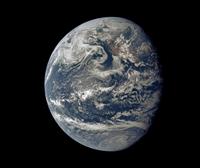
Taken by the crew of Apollo 11, 16th July 1969, about 10,000 nautical miles from Earth. Portions of North and Central America are visible under swirling clouds. |
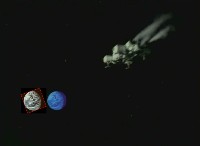 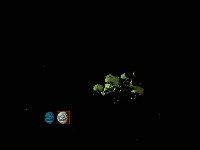
A blue monochrome version of this shot is used as Planet D in Brian The Brain and Sunim in Matter Of Balance. |
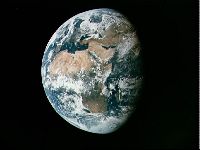
Taken by the crew of Apollo 11 during its translunar insertion on 16th July 1969, about 98,000 nautical miles from Earth. Africa can be seen, with parts of Europe and Asia. |
 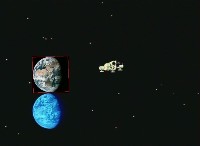
A blue monochrome version is used as New Earth in New Adam, New Eve and Luton in Rules Of Luton. The Earth in this shot in Breakaway is the same Apollo 11 photograph. Earth is low over the lunar horizon and the north pole is at the bottom; therefore, Moonbase Alpha must be located near the lunar south pole. |
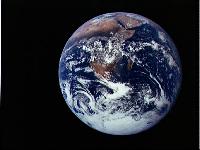
View of the Earth as seen by the Apollo 17 crew travelling toward the moon. This translunar coast photograph extends from the Mediterranean Sea area to the Antarctica south polar ice cap. This is the first time the Apollo trajectory made it possible to photograph the south polar ice cap. Note the heavy cloud cover in the southern hemisphere. Almost the entire coastline of Africa is clearly visible. The Arabian Peninsula can be seen at the north-eastern edge of Africa. The large island off the coast of Africa is Madagascar. The Asian mainland is on the horizon toward the north-east. |

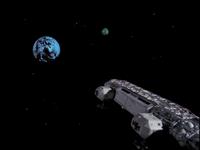
Used in the Space News titles in Dragon's Domain. A reversed and rotated version is seen as Ellna in the first shot in Devil's Planet. Also as the planet in Immunity Syndrome. 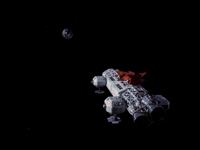
|

The ATS-3 satellite (launched 10 November, 1967) took the first full-disk, colour images of the Earth from space. This image shows South America from a distance of 36,000km. |
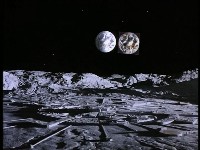 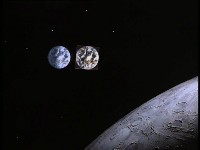
Used in Breakaway. The photograph (tilted 85 degrees to the left) rotates into view above Moonbase Alpha as the waste dumps explode below the horizon. The photograph is used again later in the episode, as the Moon is receding from Earth. |
 Interestingly, most of the scenes in Breakaway feature a matte painting of Earth rather actual space images. The same painting (clearly inspired by the ATS-3 image above) was also used in Another Time, Another Place Interestingly, most of the scenes in Breakaway feature a matte painting of Earth rather actual space images. The same painting (clearly inspired by the ATS-3 image above) was also used in Another Time, Another Place |
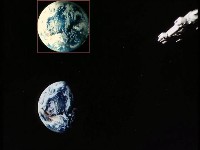
In Breakaway, different portions of the painting were darkened in different scenes to simulate diurnal phases. The opening shot of Koenig's Eagle features a mirrored image of a waxing gibbous Earth (here inverted for clarity) 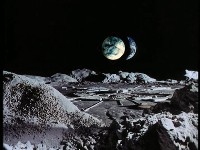
Breakaway. Most of the views of Earth from Moonbase features the same painting, now tilted ~145 degrees to the left. The Earth is now in the waning crescent phase, as seen from the lunar southern hemisphere. |
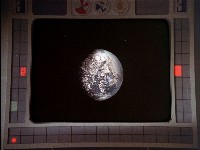

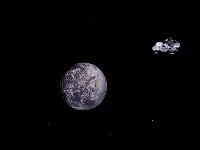
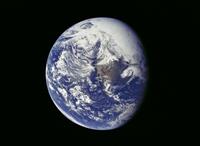
Retha in The Full Circle is a painting based on (or painted over) a NASA photograph. It was taken from Apollo 16 on 16 April, 1972, showing the US and Mexico below extensive cloud cover. In the Space: 1999 version, additional ribbons of cloud obscure the landmass. Notice the distinctive circular cloud feature over the north Pacific is identical in both the NASA photo and the Space 1999 version. Thanks to Paul White.
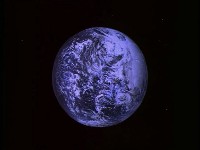
The same picture of Retha appears as "Earth" in Bringers of Wonder part 2. Perhaps the malevolent aliens have probed Carter's mind, creating a mirage from his memories of a previous encounter with a lush habitable planet...
Contents copyright Martin Willey